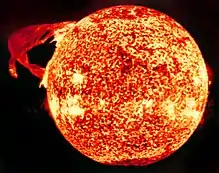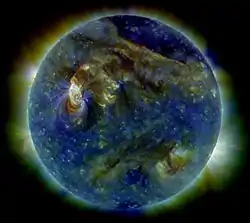List of solar telescopes
This is a list of solar telescopes built in various countries around the world. A solar telescope is a specialized telescope that is used to observe the Sun.
This list contains ground-based professional observatory telescopes at optical wavelengths in chronological order. Solar telescopes often have multiple focal lengths, and use a various combination of mirrors such as coelostats, lenses, and tubes for instruments including spectrographs, cameras, or coronagraphs. There are many types of instruments that have been designed to observe Earth's Sun, for example, in the 20th century solar towers were common.
Existing large solar telescopes
| Name/Observatory | Image | Aperture d. | Year(s) | Location | Country(s) | Note |
|---|---|---|---|---|---|---|
| Daniel K. Inouye Solar Telescope (DKIST) | 400 cm[1] | 2019-[2] | Maui, Hawaii, USA | First light early December 2019,[3] first routine scientific observations season planned for 2021[4] | ||
| Chinese Large Solar Telescope (CLST) | - | 180 cm | 2019 - | Western part of China | First light 10 December 2019[5] | |
| GREGOR, Teide Observatory | 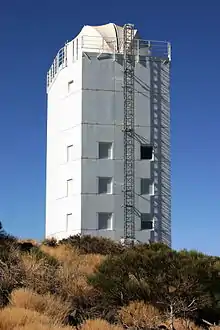 | 150 cm | 2012– | Tenerife, Spain | [6] | |
| Goode Solar Telescope (GST), Big Bear Solar Observatory | 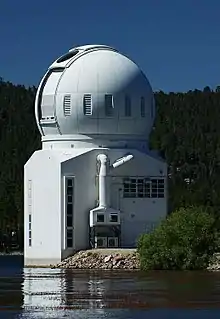 | 160 cm | 2008– | California, United States | Located in a lake. | |
| New Vacuum Solar Telescope (NVST), Yunnan Astronomical Observatory | - | 100 cm | 2010– | Yunnan, China | 100 cm vacuum solar telescope[7] | |
| Andrei Severny Tower Solar Telescope, Crimean Astrophysical Observatory | 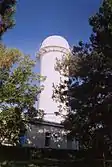 | 90 cm | 1954– | Crimea | - | |
| Multi-purpose automated solar telescope, Sayan Solar Observatory[8] | - | 80 cm | – | Mondy, Republic of Buryatia, Russia | Located in the mountains at 2000m altitude. | |
| Large Solar Vakuum Telescope, Baikal Astrophysical Observatory[9] | .jpg.webp) | 76 cm | 1980– | Irkutsk_Oblast, Russia | Located on the Coast of Lake Baikal. | |
| Optical and Near-Infrared Solar Eruption Tracer (ONSET), School of Astronomy & Space Science, Nanjing University | - | 3x27,5 cm | 2010– | Nanjing, China | The ONSET consists of four tubes: (1) a near-infrared vacuum tube, with an aperture of 27.5 cm, (2) a chromospheric vacuum tube, with an aperture of 27.5 cm, (3) a WL vacuum tube, with an aperture of 20 cm and (4) a guiding tube.[10] | |
| Bulgarian 15-cm Solar Coronagraph,[11] NAO - Rozhen | - | 100 cm | 2005– | Rozhen, Bulgaria | ||
| Swedish 1-m Solar Telescope[12](SST), ORM | 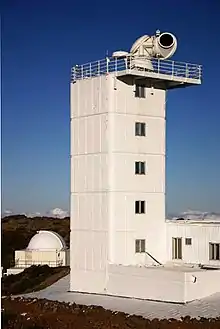 | 100 cm | 2002– | La Palma, Spain | ||
| Prairie View Solar Observatory (PVSO) | 35 cm | 1999– | Texas, USA | |||
| Dutch Open Telescope (DOT), ORM | 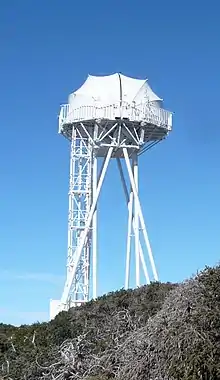 | 45 cm | 1997– | La Palma, Spain | ||
| THÉMIS Solar Telescope, Teide Obs. | 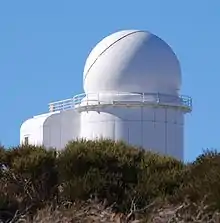 | 90 cm | 1996– | Tenerife, Spain | ||
| Vacuum Tower Telescope (VTT),[13] Teide Obs. |  | 70 cm | 1989– | Tenerife, Spain | ||
| Hida Domeless Solar Telescope[14] (ja) | - | 60 cm | 1979– | Takayama, Gifu, Japan | ||
| Udaipur Solar Observatory MAST Full Disk H-alpha Telescope H-alpha Spar Telescope Coudé Telescope |  | 50 cm 15 cm 25 cm 15 cm | 1976– | Udaipur, India | ||
| Richard B. Dunn Solar Telescope (DST), Sacramento Peak |  | 76 cm | 1969– | Sunspot Solar Observatory, Sunspot, New Mexico, USA | ||
| Solar Observatory Tower Meudon | 60 cm | 1968– | Meudon, France | |||
| McMath-Pierce Solar Telescope, KPO | 161 cm | 1961– | Arizona, USA | Largest aperture optical and infrared solar telescope for nearly six decades | ||
| ARIES Observatory | - | 15 cm | 1961– | Nainital, India | ||
| Solar Tunnel Telescope, Kodaikanal Solar Observatory |  | 61 cm (24 in) | 1958–[15] | Kodaikanal, India | ||
| 45-cm-Turmteleskop | - | 45 cm | 1943- | Schauinsland, Germany | ||
| Gregory Coudé Telescope |  | 45 cm | 1959- | Locarno, Switzerland | Operated by the Universitäts-Sternwarte Göttingen until 1984 and by IRSOL after 1984. | |
| Solar Tower Telescope by Zeiss[16] | - | 45 cm | 1930– | Tokyo, Japan | ||
| Einsteinturm | 60 cm | 1924– | Potsdam, Germany | |||
| 150-foot tower,[1] Mount Wilson Observatory |  | 35 cm (24") | 1912– | California, USA | ||
| Snow Solar Telescope,[17] Mount Wilson Observatory | - | 61 cm (24") | 1904– | California, USA | first solar tower telescope | |
| Lerebour/Grubb-Parsons, Kodaikanal Solar Observatory | 20 cm | 1901– | Kodaikanal, India | |||
Former solar telescopes after 1900
| Name/Observatory | Image | Aperture d. | Year(s) | Location | Country(s) | Note |
|---|---|---|---|---|---|---|
| Swedish Vacuum Solar Telescope, ORM | - | 47.5 cm | 1985–2000 | La Palma, Spain | Replaced by the SST | |
| Gregory Coude Telescope (GCT)[18] | 45 cm[1] | 1984–2002 | Tenerife, Spain (1984–2002) | Replaced by GREGOR | ||
| Evans Solar Facility (ESF),[19] Sacramento Peak | 40 cm | 1953–2014 | Sunspot Solar Observatory, Sunspot, New Mexico, USA | Also a coronagraph | ||
| Göttinger Sonnenturm (Solar Tower Telescope, Zeiss 1942) | 2x15 cm 11 cm | 1942–2004 | Göttingen, Germany | 65 cm-Coelostat by Zeiss, feeding light into several small light paths in tower | ||
| McMath-Hulbert Observatory | - | 61 cm (24") | 1941–1979 | Michigan, USA | Replaced the 10.5in in 1941 | |
| 50-foot tower, McMath-Hulbert Observatory | - | 40 cm | 1936–1979 | Michigan, USA | ||
| 10.5 inch, McMath-Hulbert Observatory | - | 26.7 cm (10.5") | 1930–1941 | Michigan, USA | Replaced by the 24 inch in 1941 | |
| Arcetri solar tower |  | 37 cm | 1925-2006 | Arcetri, Italy | ||
Telescopes for the Sun have existed for hundreds of years, this list is not complete and only goes back to 1900.
Potential future solar telescopes
| Name/Observatory | Image | Aperture d. | Status | Location | Country(s) | Note |
|---|---|---|---|---|---|---|
| COronal Solar Magnetism Observatory (COSMO)[20] | - | 150 cm | proposed | Hawaii, USA | ||
| National Large Solar Telescope (NLST) | - | 200 cm | proposed[21] | Merak Village, Ladakh, India | ||
| Chinese Giant Solar Telescope (CGST)[22] | - | 500–800 cm | planned | Western part of China | ||
| European Solar Telescope (EST)[23] | - | 400+ cm | planned | Canary Islands | 15 European countries[24] | |
Other types of solar telescopes
There are much smaller commercial and/or amateur telescopes such as Coronado Filters from founder and designer David Lunt, bought by Meade Instruments in 2004 and sells SolarMax solar telescopes up to 8 cm[25][26]
Most solar observatories observe optically at visible, UV, and near infrared wavelengths, but other things can be observed.
- CERN Axion Solar Telescope (CAST), looks for solar axions in the early 2000s
- Multi-spectral solar telescope array (MSSTA), a rocket launched payload of UV telescopes in the 1990s
- Leoncito Astronomical Complex, has a submillimeter wavelength solar telescope.
- Owens Valley Solar Array, for solar radio observation
References
- "Big Bear Solar Observatory - Large Solar Telescopes".
- "Welcome to the DKIST | DKIST".
- Witze, A. (29 January 2020). "World's most powerful solar telescope is up and running". Nature. doi:10.1038/d41586-020-00224-z.
- "Cycle 1 Proposal Call Announcement". NSO/DKIST. Retrieved 2021-01-31.
- "First light of the 1.8-m solar telescope–CLST". SCIENCE CHINA Physics, Mechanics & Astronomy. 22 April 2020. Retrieved 7 September 2020.
- GREGOR Website at KIS, Freiburg
- http://www.iau.org/static/scientific_meetings/iau_ga_2012/speeches/su_ding_qiang.pdf
- http://en.iszf.irk.ru/Main_Page Institute of Solar-Terrestrial Physics
- http://en.iszf.irk.ru/Main_Page Institute of Solar-Terrestrial Physics
- Hao, Q.; Guo, Y.; Dai, Y.; Ding, M. D.; Li, Z.; Zhang, X. Y.; Fang, C. (2012). "Understanding the white-light flare on 2012 March 9: Evidence of a two-step magnetic reconnection". Astronomy & Astrophysics. 544: L17. arXiv:1211.1751. Bibcode:2012A&A...544L..17H. doi:10.1051/0004-6361/201219941.
- "Archived copy". Archived from the original on 2010-08-08. Retrieved 2015-06-16.CS1 maint: archived copy as title (link)
- solarphysics.kva.se The Swedish 1 m Solar Telescope Archived 2008-06-16 at the Wayback Machine
- "Archived copy". Archived from the original on 2009-12-26. Retrieved 2009-02-28.CS1 maint: archived copy as title (link)
- "The Domeless Solar Telescope".
- "I.S. Glass's home page".
- "Archived copy". Archived from the original on 2006-03-10. Retrieved 2014-08-30.CS1 maint: archived copy as title (link)
- "Telescope: Snow Solar Telescope".
- "Archived copy". Archived from the original on 2011-09-29. Retrieved 2010-09-24.CS1 maint: archived copy as title (link)
- https://nsosp.nso.edu/esf
- http://www.cosmo.ucar.edu/
- "Archived copy". Archived from the original on 2010-09-05. Retrieved 2010-09-16.CS1 maint: archived copy as title (link)
- Y. Y. Deng (21 March 2011). "Introduction to the Chinese Giant Solar Telescope" (PDF). www.ncra.tifr.res.in. Retrieved 11 May 2020.
- "Home".
- http://www.astro-east.org/
- Sky & Telescope: David Lunt (1942-2005)
- David Lunt biography, Solar Filter designer Archived 2011-07-23 at the Wayback Machine
